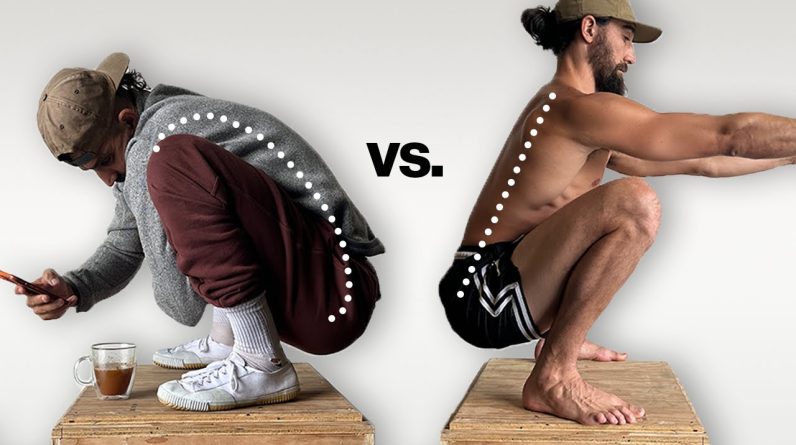
Over the years, there has been a widespread belief that squatting, especially if the knees are bent beyond 90°, can be harmful and lead to knee, hip, and back pain. However, in recent years, there has been a renewed interest in the squat as an essential exercise in strength and conditioning programs.
Over the years, there has been a widespread belief that squatting, especially if the knees are bent beyond 90°, can be harmful and lead to knee, hip, and back pain. However, in recent years, there has been a renewed interest in the squat as an essential exercise in strength and conditioning programs. Many fitness enthusiasts now consider squats the ultimate exercise, as they offer benefits beyond muscle building and fat burning.
Squatting can positively impact joint mobility, spine decompression, relief of lower back tension, and even aid digestion. For individuals with limited hip or ankle flexibility, adaptation tips can help them get comfortable in a squat position.
Spending time in a deep squat can also significantly improve ankle and foot health. Investing in Vivo shoes can be particularly beneficial in facilitating improved squatting experiences. It’s important to gradually increase the time spent in a squat without relying on chairs, and using a timer to track progress can lead to noticeable improvements.# The Ultimate Guide to Squatting: Benefits, Techniques, and Tips for Improved Health
## Introduction
In the realm of fitness, the squat has garnered significant attention and acclaim. Once feared for its potential to cause knee, hip, and back pain, squatting is now celebrated as one of the most beneficial exercises for overall strength and conditioning. This blog post delves into the many advantages of squatting, dispels common myths, and provides practical tips for improving your squat form and flexibility.
## The Benefits of Squatting
### 1. Enhanced Joint Mobility
Squatting regularly can greatly improve joint mobility, particularly in the hips, knees, and ankles. This increased mobility can translate to better performance in various physical activities and reduce the risk of injuries.
### 2. Spine Decompression
Contrary to popular belief, squatting can help decompress the spine. When performed correctly, squats engage the core muscles, providing support to the spine and alleviating tension in the lower back.
### 3. Improved Digestion
The deep squat position can aid in digestion by promoting better bowel movements. This is especially beneficial for individuals who spend long hours sitting, as squatting can counteract the adverse effects of prolonged sitting.
### 4. Enhanced Ankle and Foot Health
Spending time in a deep squat can significantly improve the health of your ankles and feet. This position stretches the tendons and ligaments, promoting flexibility and strength in these areas.
## Debunking Squat Myths
### Myth 1: Squatting Beyond 90° is Harmful
One of the most persistent myths is that bending the knees beyond 90° during a squat can cause damage. However, research has shown that deep squats, when performed with proper form, do not increase the risk of knee injuries. They can be more beneficial for joint health than shallow squats.
### Myth 2: Squats are Bad for Your Back
Another common misconception is that squats can harm your back. On the contrary, squats can help strengthen the muscles that support the spine, reducing the risk of back pain. The key is maintaining proper form and avoiding overloading the spine with excessive weight.
## Tips for Improving Your Squat Form
### 1. Focus on Flexibility
It’s crucial to work on improving hip or ankle flexibility for individuals with limited hip or ankle flexibility. Stretching exercises, foam rolling, and yoga can contribute to better flexibility and, consequently, a more comfortable squat position.
### 2. Use Adaptation Tips
If you’re struggling to get into a deep squat, consider using tools like a stability ball or a weightlifting belt to support your body. Gradually increase the depth of your squats as your flexibility improves.
### 3. Invest in Vivo Shoes
Vivo shoes are designed to mimic the foot’s natural shape, providing better balance and stability during squats. Investing in a pair can facilitate a more natural and comfortable squatting experience.
### 4. Gradually Increase Squat Duration
Start by spending a few minutes in a squat position each day and gradually increase the duration. Using a timer can help you track your progress and ensure that you’re consistently improving.
### 5. Prioritize Form Over Weight
It’s essential to prioritize proper form over the weight you’re lifting. Focus on maintaining a straight back, engaging your core, and ensuring your knees align with your toes.
## Conclusion
Squatting is more than just a muscle-building exercise; it offers many benefits that can enhance your overall health and well-being. You can reap the rewards of this powerful exercise by debunking common myths, focusing on flexibility, and gradually increasing your squat duration. So, take the time to perfect your squat form, invest in the right gear, and enjoy the benefits of incorporating squats into your fitness routine.
Many fitness enthusiasts now consider squats the ultimate exercise, as they offer benefits beyond muscle building and fat burning. Squatting can positively impact joint mobility, spine decompression, relief of lower back tension, and even aid digestion. For individuals with limited hip or ankle flexibility, adaptation tips can help them get comfortable in a squat position.
Spending time in a deep squat can also significantly improve ankle and foot health. Investing in Vivo shoes can be particularly beneficial in facilitating improved squatting experiences. It’s important to gradually increase the time spent in a squat without relying on chairs, and using a timer to track progress can lead to noticeable improvements.
Read More: Say Goodbye to Sciatica Pain with the Right Core Exercises: 3 Safe Options
Read More: Low and Slow Prime Rib – Easy No Fail Prime Rib Method – Food Wishes
Read More: Explore The Active Balance Retreat A Journey to Holistic Wellness






